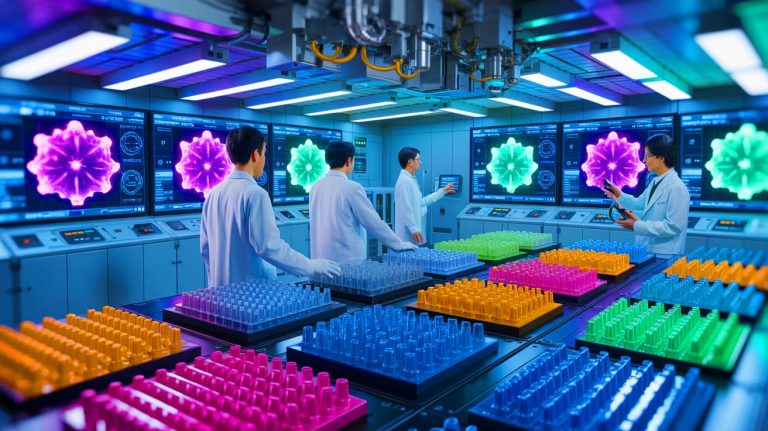| IN A NUTSHELL |
|
In recent years, significant advancements have been made in the field of recycling, particularly with regard to the treatment of persistent and challenging materials like polytetrafluoroethylene (PTFE), commonly known as Teflon. Researchers in Japan have introduced a new recycling technique that promises to transform the landscape of sustainable waste management. This breakthrough utilizes an electron beam to effectively decompose PTFE at lower temperatures, significantly reducing the energy required for the process. As global efforts intensify to address the environmental impacts of “forever chemicals,” such innovations are becoming increasingly crucial. This article will explore the implications of this new technology and its potential to reshape recycling practices worldwide.
Understanding Electron Beam Technology
Electron beam technology represents a cutting-edge approach to decomposing durable materials like PTFE. By applying moderate heat in conjunction with electron beam irradiation, researchers have discovered a method to efficiently break down these materials. Initial attempts at room temperature yielded limited success, decomposing merely 10% of PTFE. However, the process becomes significantly more effective at elevated temperatures. At 518 °F, the decomposition rate jumps to 86%, eventually achieving complete decomposition at 698 °F. This process converts solid PTFE into gaseous products, such as oxidized fluorocarbons and perfluoroalkanes, which can be utilized as raw materials in chemical manufacturing.
This innovation marks a substantial shift in recycling methodologies, as it reduces the energy consumption associated with traditional pyrolysis methods. Dr. Akira Idesaki, a senior principal researcher, highlighted the dual benefits of improved recycling efficiency and the feasibility of large-scale applications. By halving the energy needs from the conventional 2.8 to 4 MWh per ton, this technique stands as a significant step forward in sustainable industrial practices.
Transformative Changes in PTFE Structure
An intriguing facet of the electron beam method is its impact on the internal structure of PTFE. The irradiation not only facilitates decomposition but also induces molecular-level restructuring. Dr. Hao Yu, the study’s first author, noted that these structural modifications are key to the enhanced efficiency observed at higher temperatures. PTFE’s known robustness, attributed to its strong carbon-fluorine bonds, places it among the PFAS family of chemicals, often referred to as “forever chemicals” due to their persistence in the environment.
While this durability is advantageous in industrial applications, it poses formidable environmental challenges. The new recycling method represents a pivotal advancement in addressing these issues, offering a safer and more cost-effective solution. Dr. Yasunari Maekawa, the project lead, emphasized that this development could lead to cleaner and more sustainable recycling practices for high-performance plastics, thus mitigating their environmental footprint.
Global Initiatives to Address PFAS Challenges
The environmental challenges posed by “forever chemicals” like PFAS have prompted a global response, with numerous research initiatives dedicated to finding innovative solutions. One notable example comes from the University of Leicester, where researchers have developed a technique utilizing sound waves to separate materials for recycling. Dr. Jake Yang, a lead researcher, described this method as both simple and scalable, allowing for the separation of PFAS membranes from precious metals without the use of harsh chemicals.
These technological advancements are vital in preventing hazardous chemicals from contaminating ecosystems and impacting human health. The growing recognition of the need for sustainable recycling solutions underscores the importance of continued research and collaboration across the globe. As these efforts progress, they offer hope for a more environmentally conscious future.
The Potential for Future Innovations in Recycling
As the world confronts the pressing environmental challenges associated with plastic waste, technological innovations like electron beam recycling of PTFE provide a beacon of hope. By dramatically reducing energy consumption and enabling the reuse of resources, these methods enhance both economic viability and environmental sustainability. Transforming solid waste into valuable feedstock has the potential to revolutionize industrial waste management practices.
The integration of such technologies into mainstream recycling processes could significantly lessen the environmental impact of plastics. As researchers continue to refine these methods, the vision of a cleaner, more sustainable future becomes increasingly achievable. How might these innovations influence global recycling strategies, and what new breakthroughs could emerge in the fight against plastic pollution?
Did you like it? 4.6/5 (20)






Wow, this is mind-blowing! Can this tech be used for other plastics too? 🌍
Finally, a solution for forever chemicals! Thank you, Japan! 🙌
Sounds promising, but how cost-effective is this on a global scale?
The future is here! How soon can we expect this to be implemented worldwide? 🚀
Are there any potential negative environmental impacts from this technology?
If it sounds too good to be true, it usually is. What’s the catch? 🤔
How does this compare to sound wave techniques in efficiency?
Does this mean we can finally move away from single-use plastics?
Isn’t it risky to rely so heavily on one technology for waste management?
Lol, I thought vaporizing plastics was only possible in sci-fi movies! 🎬
What are the long-term effects of using electron beams on the environment?
Great, but how can developing countries access and utilize this technology?
This is a game-changer for recycling! Kudos to the researchers! 👏
Are there any health risks associated with the gaseous byproducts?
How does this impact current recycling jobs and industries?
I’m amazed! Could this tech also reduce ocean pollution?
This is incredible news! How soon can we see real-world applications?
Is the technology patented, or can other countries implement it freely?
Another breakthrough from Japan! They never cease to impress. 🇯🇵
How does this technology handle mixed plastic waste?
Can this be used to recycle other PFAS chemicals, not just Teflon?
Is the energy reduction significant enough to make a global impact?
What about the cost of setting up these facilities? 🚧
Hope this doesn’t get stuck in bureaucratic red tape! 🏛️
How do we ensure the gaseous products are safely managed?
Could this be the end of landfills as we know them?
Does this require specific conditions or climates to operate efficiently?
Finally, a step towards a circular economy! Let’s make it happen. 🌱
How do we deal with the political and economic barriers in adopting this tech?
What are the scalability challenges of this technology?
Can this be integrated with existing recycling systems without major overhauls?
I’m a bit skeptical. How reliable is the data supporting this innovation?
Is there any international collaboration on this technology? 🌐
How does this affect the carbon footprint of recycling operations?
Can this technology handle other complex waste materials like electronic waste?
What a breakthrough! Let’s hope it’s not just another headline. 📈